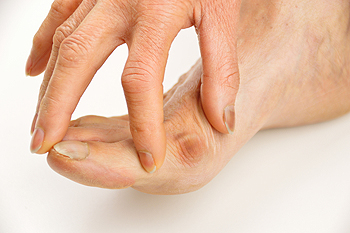

Many people who have bunions are concerned that it is a cosmetic condition. There are some patients who are aware they may cause pain, and this can hinder completing daily activities. The medical term for a bunion is referred to as hallux valgus, and it is defined as a bony lump on the side of the big toe. It gradually develops from genetic reasons, or from wearing shoes that do not have enough room for the toes to move freely in. It will begin as a small bump, and will gradually increase in size if the same type of shoes are frequently worn. It can affect the other toes by pushing against them, and this can cause them to shift. Some patients develop corns and calluses on top of the shifted toes, and bursitis can develop in the affected joint of the big toe. There are protective pads that can be worn over the bunion until larger shoes are purchased. If you see the first sign of a bunion, or if it has increased in size, it is strongly advised that you are under the care of a podiatrist who can possibly recommend surgery for permanent relief.
If you are suffering from bunions, contact Dr. Todd Goldberg of Complete Family Foot Care Center. Our doctor can provide the care you need to keep you pain-free and on your feet.
What Is a Bunion?
A bunion is formed of swollen tissue or an enlargement of boney growth, usually located at the base joint of the toe that connects to the foot. The swelling occurs due to the bones in the big toe shifting inward, which impacts the other toes of the foot. This causes the area around the base of the big toe to become inflamed and painful.
Why Do Bunions Form?
Genetics – Susceptibility to bunions are often hereditary
Stress on the feet – Poorly fitted and uncomfortable footwear that places stress on feet, such as heels, can worsen existing bunions
How Are Bunions Diagnosed?
Doctors often perform two tests – blood tests and x-rays – when trying to diagnose bunions, especially in the early stages of development. Blood tests help determine if the foot pain is being caused by something else, such as arthritis, while x-rays provide a clear picture of your bone structure to your doctor.
How Are Bunions Treated?
If you have any questions, please feel free to contact our office located in Littlestown, PA . We offer the newest diagnostic and treatment technologies for all your foot care needs.